Juniper JN0-663 Exam Questions
Questions for the JN0-663 were updated on : Jul 20 ,2024
Page 1 out of 7. Viewing questions 1-15 out of 94
Question 1
Exhibit: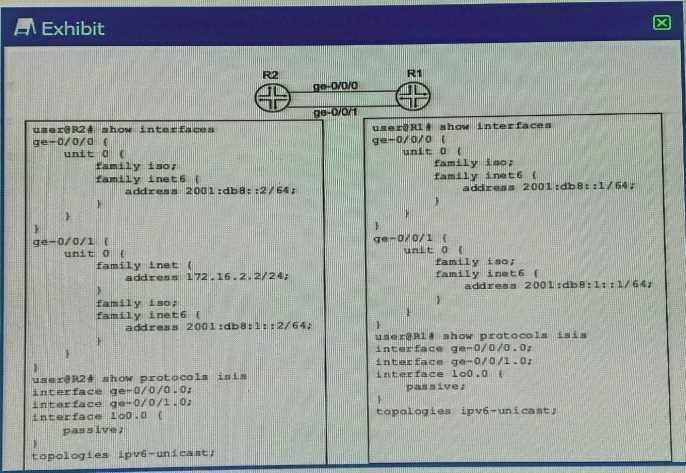
A network administrator is migrating from IPv4 to IPv6 and one of the IS-IS adjacencies is not coming
up between R1 and R2.
Which action will solve the problem?
- A. Configure an IPv4 address on interface ge-0/0/1 on R1.
- B. Configure topologies ipv4-unicast from protocols isis on R2.
- C. Remove topologies ipv6-unicast from protocols isis on R1.
- D. Remove topologies ipv6-unicast from protocols isis on R2.
Answer:
A
Question 2
Exhibit: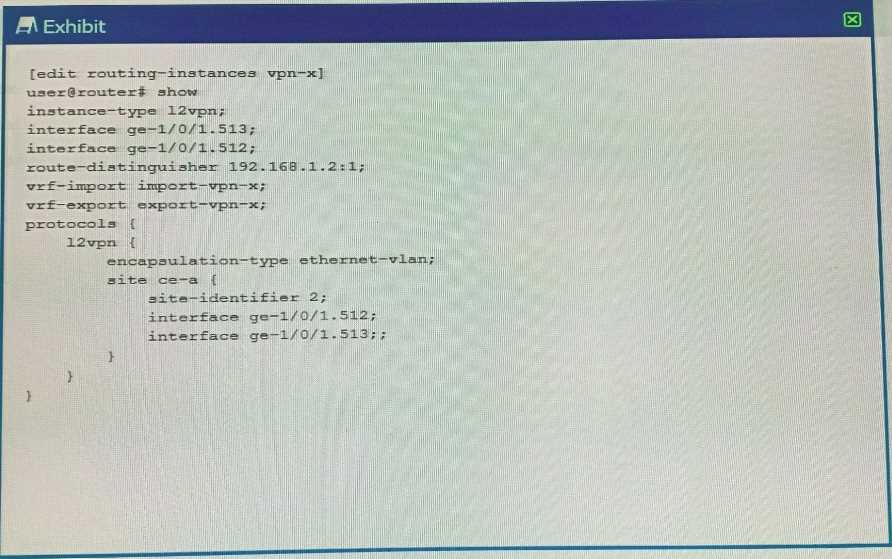
You have the Layer 2 VPN configuration shown in the exhibit. You are asked to determine the remote
site ID for ge-1/0/1.512.
In this scenario, what is the remote site ID?
- A. 5
- B. 3
- C. 1
- D. 4
Answer:
C
Question 3
Exhibit: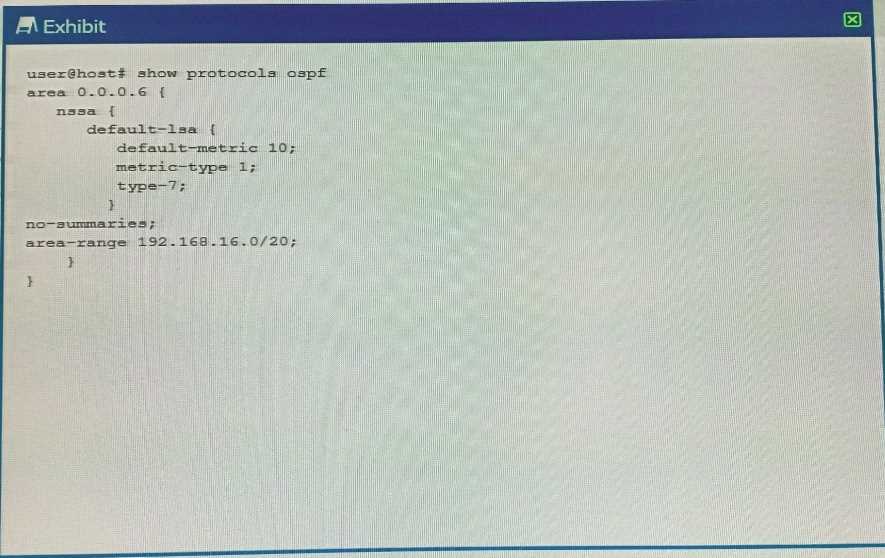
Referring to the ABR configuration shown in the exhibit, which three statements are correct? (Choose
three.)
- A. The ABR advertises a default route to the NSSA using a Type 7 LSA.
- B. The ABR advertises a single Type 5 external LSA to the backbone area for all Type 7 LSAs in the NSSA.
- C. The ABR does not summarize any routes within the 192.168.16.0/20 range.
- D. The ABR advertises a Type 5 external LSA to the backbone area for each Type 7 LSA in the NSSA.
- E. The ABR advertises a single Type 3 summary LSA to the backbone area for all Type 1 and Type 2 LSAs in the 192.168.16 0/20 range.
Answer:
A, D, E
Question 4
Exhibit: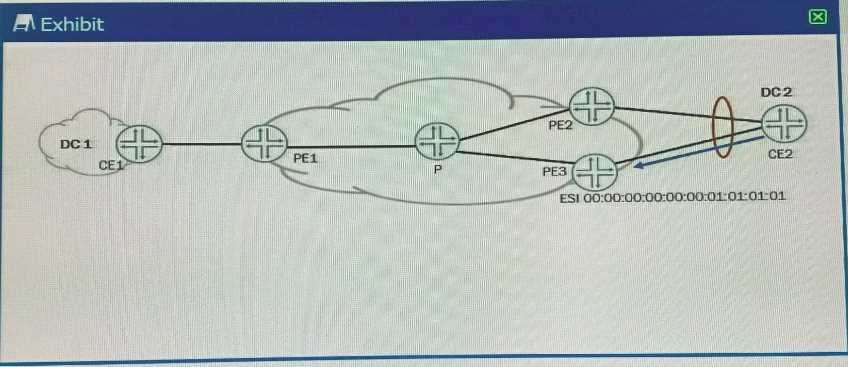
Referring to the exhibit, traffic sent from CE-A2 to PE3 does not loop back to CE-A2 through PE2.
Which two EVPN functions accomplish this task? (Choose two.)
- A. split horizon
- B. aliasing
- C. multicast ingress replication
- D. designated forwarder election
Answer:
A, D
Question 5
Exhibit: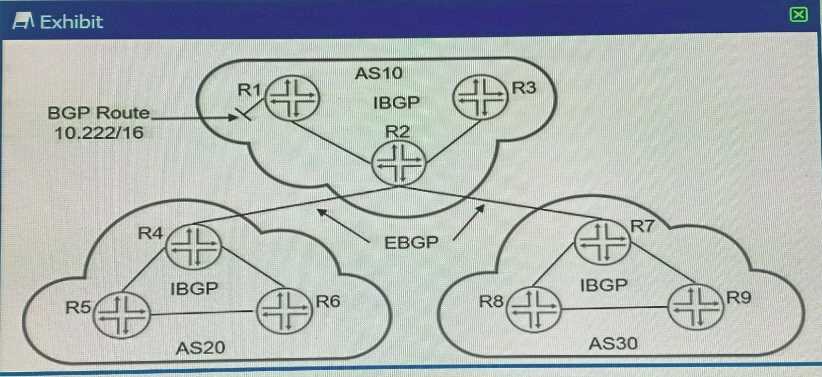
Referring to the exhibit, which three statements about route 10.222/16 are correct when using the
default BGP advertisement rules? (Choose three)
- A. R2 will advertise 10.222/16 to R4 with itself as the next hop.
- B. R2 will prepend AS10 when advertising 10.222/16 to R7.
- C. R7 will advertise 10.222/16 to R9 with itself as the next hop.
- D. R1 will advertise 10 222/16 to R2 with itself as the next hop.
- E. R1 will prepend AS10 when advertising 10.222/16 to R2.
Answer:
A, B, D
Question 6
Exhibit: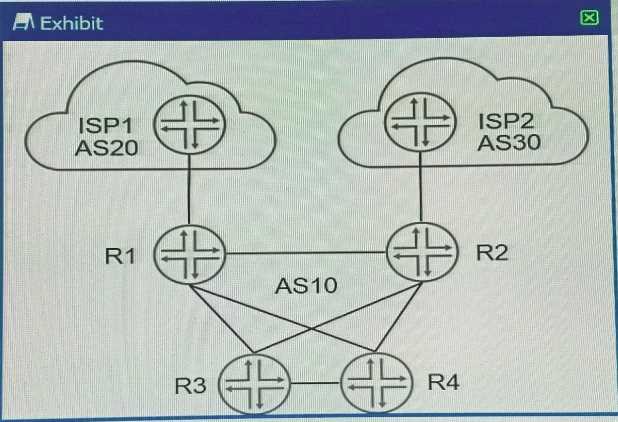
Referring to the exhibit, you want to make ISP1 your preferred connection for inbound and outbound
traffic.
Which two steps will accomplish this task? (Choose two.)
- A. Create an export policy to prepend the ASN on advertised routes and apply it to the EBGP peer on R1.
- B. Create an export policy setting local-preference 200 and next-hop self and apply it to the IBGP peers on R1.
- C. Create an export policy to prepend the ASN on advertised routes and apply it to the EBGP peer on R2.
- D. Create an export policy setting local-preference 200 and next-hop self and apply it to the IBGP peers on R2.
Answer:
B, C
Question 7
You are responsible for configuring CoS for your network Your network includes a video application
with strict latency requirements, so that any packets delayed by more than 75 ms are effectively
useless. You want to ensure that you do not waste buffer space.
When configuring the scheduler for this application, which feature would you use?
- A. exact
- B. remainder
- C. rate limit
- D. temporal
Answer:
D
Question 8
Exhibit: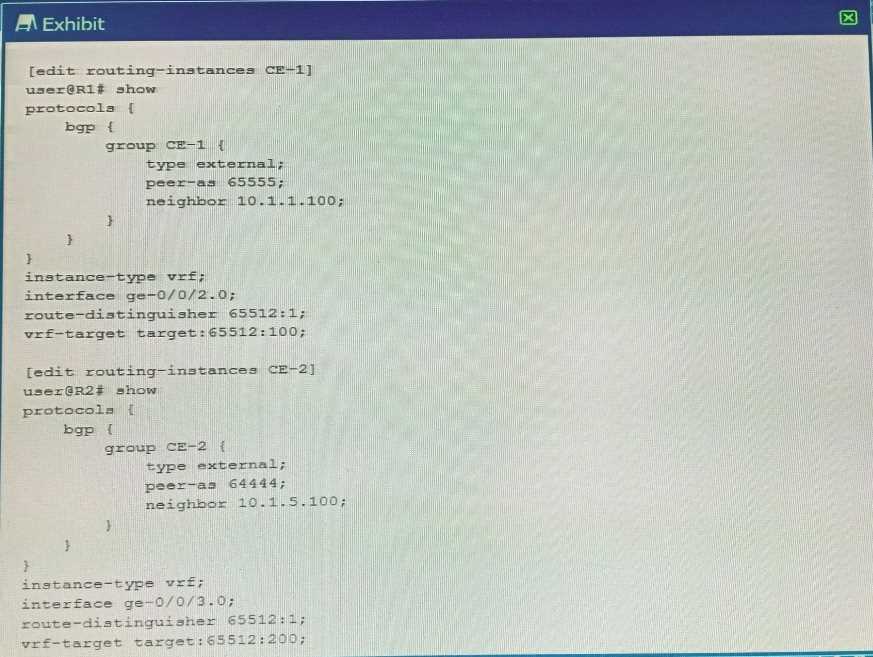
Referring to the exhibit, which two statements are true? (Choose two.)
- A. The vrf-target configuration stops routes from being shared between CE-1 and CE-2.
- B. The route-distinguisher configuration allows routes to be shared between CE-1 and CE-2.
- C. The vrf-target configuration allows routes to be shared between CE-1 and CE-2.
- D. The route-distinguisher configuration stops routes from being shared between CE-1 and CE-2.
Answer:
A, B
Question 9
Exhibit: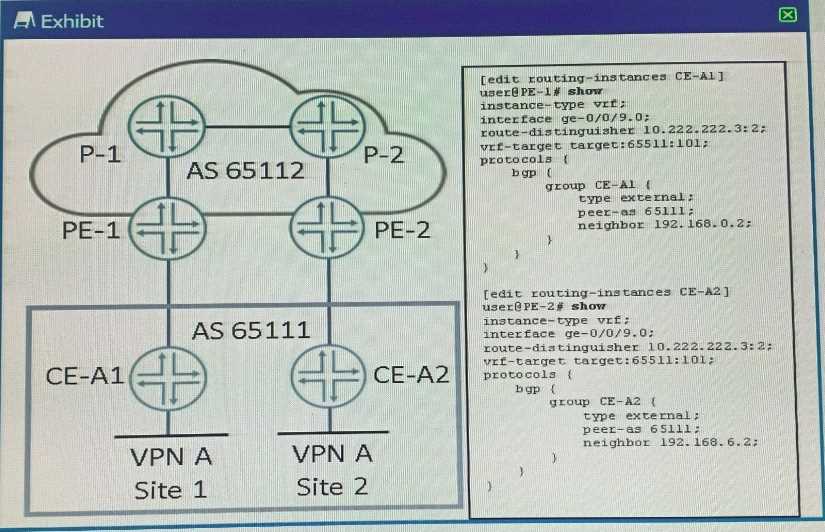
Referring to the exhibit, hosts in Site 1 and Site 2 are unable to communicate with each other
through the Layer 3 VPN.
What is the problem?
- A. The two sites are using the same route distinguishes.
- B. The two sites are in the same AS.
- C. The two sites are using the same instance type.
- D. The two sites are using the same route target.
Answer:
B
Question 10
Exhibit: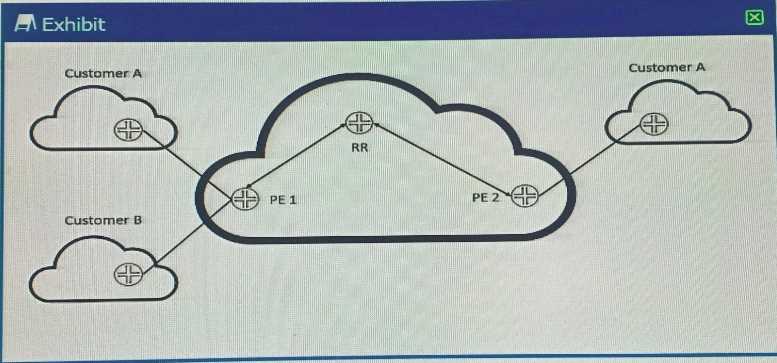
Referring to the exhibit, you want to reduce the CPU processing load on PE 2 by preventing the
receipt of routes belonging to Customer B.
In this scenario, which Layer 3 VPN scaling mechanism provides this functionality?
- A. route origin
- B. route reflection
- C. route target filtering
- D. route refresh
Answer:
C
Question 11
You are configuring a BGP signaled Layer 2 VPN across your MPLS enabled core network.
In this scenario, which statement is correct?
- A. You must ensure that all interfaces within the site's configuration are explicitly defined with their remote site identifier values.
- B. This type of VPN requires the support of the I2vpn signaling NLRI on all route reflectors and participating PE devices.
- C. You must use a unique route distinguisher value on all PE devices in your environment.
- D. This type of VPN is only supported over LSPs that are using traffic-engineering.
Answer:
B
Question 12
Exhibit: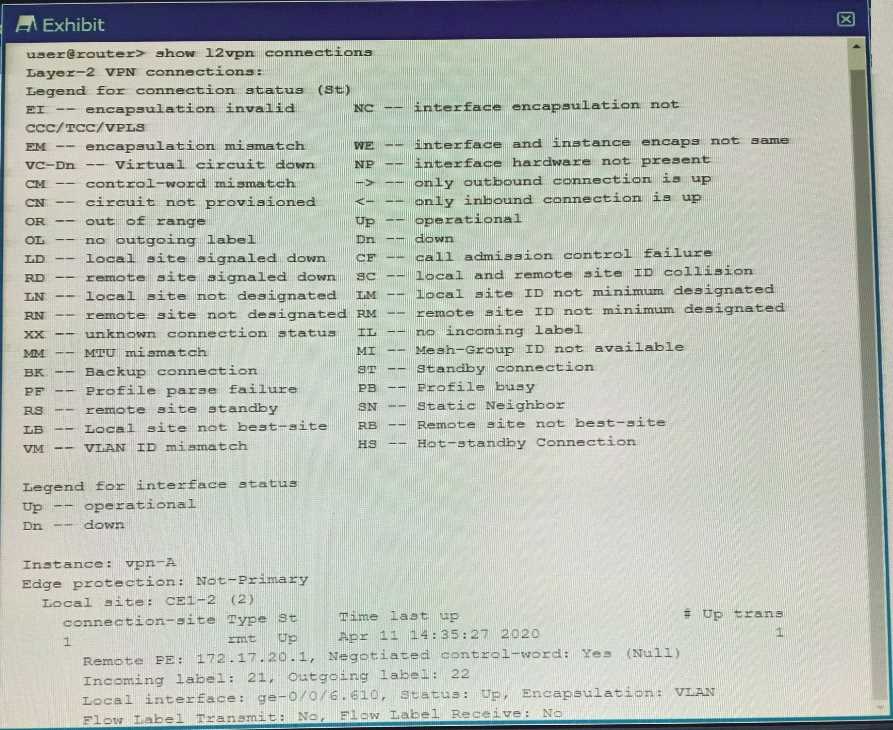
Which two statements regarding the output shown in the exhibit are correct? (Choose two.)
- A. The type of connection is remote.
- B. The type of connection is local.
- C. The PEs have matching control word values.
- D. The label associated with this virtual circuit is out of range.
Answer:
AC
Question 13
Exhibit: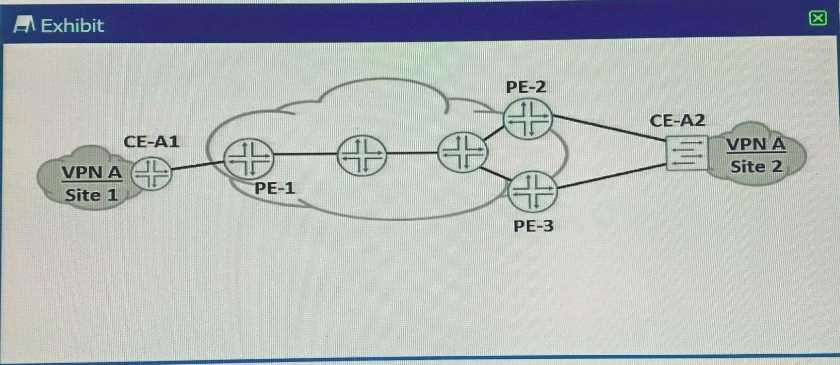
Referring to the exhibit, you need to implement VPLS between CE-A1 and CE-A2 You must ensure
that no loops are created due to the multihoming of the connection from CE-A2 to PE2 and PE3.
Based on the type of VPLS, which two solutions will satisfy this requirement? (Choose two.)
- A. In a BGP VPLS, configure a primary and backup neighbor.
- B. In an LDP VPLS. configure multihoming and local preference on PE-2 and PE-3
- C. In an LDP VPLS, configure a primary and backup neighbor.
- D. In a BGP VPLS, configure multihoming and local preference on PE-2 and PE-3.
Answer:
C, D
Question 14
Exhibit: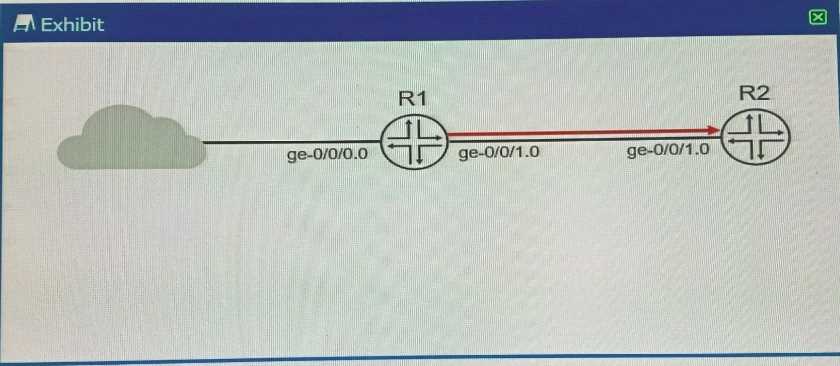
R1 assigns incoming voice traffic to the ef forwarding class. All other traffic is assigned to the best-
effort forwarding class You have configured a CoS re-write rule on R1 to include the correct CoS bit
values in packets sent towards R2 You want R2 to classify traffic using the CoS markings created by
R1.
Which two configuration steps are necessary to accomplish this task? (Choose two.)
- A. Configure a CoS re-write rule on R2 and assign matching CoS values.
- B. Assign the CoS re-write rule to the ge-0/0/1.0 interface on R2.
- C. Assign the behavior aggregate classifier to the ge-0/0/1.0 interface on R2.
- D. Configure a behavior aggregate classifier on R2.
Answer:
B, C
Question 15
You must deploy an interprovider VPN option that ensures that the ASBRs do not need to store any
VPN routes.
In this scenario, which interprovider VPN option should you choose?
- A. option B
- B. option A
- C. option C
- D. option D
Answer:
C